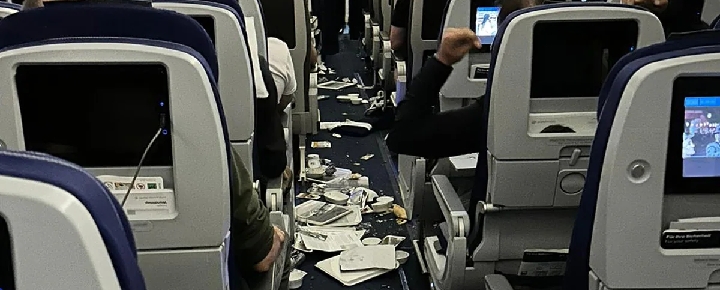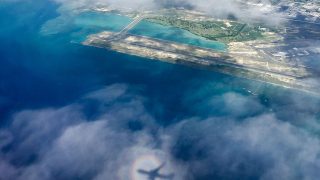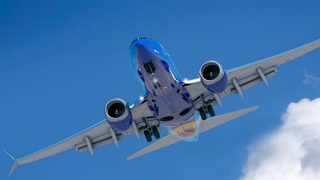In another dramatic sequence reminiscent of past incidents reported on Beat of Hawaii, passengers aboard United Airlines flight UA-1273 from San Francisco to Kahului Maui faced a frightening encounter with turbulence this week. The event mirrors several past episodes where Hawaii flights have grappled with the capricious nature of Pacific weather, underscoring an ongoing point of awareness for air travelers to the islands.
Turbulence incident en route to Hawaii.
Amidst their journey to Kahului yesterday, passengers were abruptly reminded of the hazards of air travel when unexpected turbulence triggered the release of the Boeing 777-200’s oxygen masks—a safety measure which, while obviously concerning, is designed to ensure everyone’s safety. It was reported that the release of the masks, however, may have been caused by a faulty sensor. “A passenger reported the aircraft encountered turbulence and the oxygen masks were released. The crew subsequently announced there was a sensor malfunction.” This incident adds to the growing list of turbulence-related events affecting flights to and from Hawaii, a topic we’ve frequently covered in reports.
Historic aircraft with a long legacy.
The aircraft involved in this incident, United’s N777UA, was the very first plane of this type (Boeing 777) delivered to United Airlines. It began flying in May 1995, and is over 29 years old. The plane, early on, was in service across the Atlantic, and it has been regularly used for Hawaii flights too. It was grounded during Covid, before returning to service.
Flight aftermath and impact on Hawaii-bound travel.
We can confirm that the aircraft landed safely in Kahului, one of Hawaii’s busiest airports, at 10:57 am, after having departed San Francisco at 9:04 am. The ordeal’s impact, however, didn’t conclude upon touchdown. A subsequent cancellation of the return flight, UA-1722, was deemed necessary, in order for required safety checks and aircraft inspections to take place, something not unusual in such situations. The aircraft has since returned to San Francisco.
Reflecting on Hawaii turbulence incidents.
Drawing parallels with previous turbulence events covered by Beat of Hawaii, such as the Hawaiian Airlines flight last year, or their more serious prior mass injury event on approach to Honolulu, this latest occurrence is part of a discernible pattern of flight challenges over the Pacific.
Our recent article, “Three Hawaii Flight Incidents Spotlighted Amid Global Air Turbulence Surge,” highlighted these significant incidents and discussed the broader context of increasing turbulence worldwide as well as ongoing turbulence mitigation efforts by all of the airlines serving Hawaii.
Turbulence mitigation efforts for Hawaii.
Current efforts to mitigate turbulence impacts include advancements in related detection technology and updated protocols for flight crew training. Tools such as NOAA’s Graphical Turbulence Guidance tool are proving crucial in predicting and navigating turbulent areas, hoping to enhance passenger and crew safety on flights to and from Hawaii and elsewhere.
Increase in turbulence frequency affecting Hawaii flights.
Research data from the American Geophysical Union and the University of Reading, as discussed in our prior article “Buckle Up! Hawaii Flight Air Turbulence Increasing,” indicate a notable rise in turbulence over the past four decades. This increase is likely exacerbated by climatic changes, affecting flight patterns and safety worldwide, with a notable impact on routes to Hawaii. The research underscores the necessity for passengers and airlines to remain vigilant and prepared for such occurrences. Seat belts anyone!
Hat tip to Aviation Herald for first reporting on this. Lead image courtesy Flickr.
Get Breaking Hawaii Travel News






I remember when I was invited to a “roll-out” so to speak of this 777 when UAL offered invited guests and select media to tour this then new and first 777 at LAX back in 1995.
I was in line behind Jim Goodwin – on the tarmac waiting to board via stairs. Jim back then was head of UAL’s North America division – he was a tall drink of water. Jim eventually became CEO UAL before being abruptly ousted…so sad.
For a new plane, especially a wide-body, I remember how “advanced” UAL’s 777-222 was compared to the 767 and 747.
To this day, I enjoy my flights on UAL’s domestic 777-222’s – as long as I’m seated in first – and not the “backwards” facing seats!
First is best of course, but I wish they’d put first over the wings. Less turbulence, and I like to make sure they are functioning correctly….always keep eye on the flaps!
Bottom line: Despite some who may believe otherwise, humans aren’t in charge, Nature is…
Best Regards
Mahalo, But I have read all the books on flying, carry White Nuckles on the plane, plus and am a 35 year sailor so I know the physics, and still freak at the bumpy rides. As we sailors still say, if a sailboat stalls, it still won’t sink.
Just wait till you experience the price gouging after landing. You may have wished you had kept the oxygen mask on. Greed will also zap the oxygen right out of you. Turbulence might be the least of your worries.
Yes there is and always will be turbulence on airflights. I used to be terrified, until I educated myself about it. I took a flying lesson in a small plane near my city. It just so happened that we had one of the hottest days in history for temps- 105 degrees in the Northwest that day I took my flying lesson. But what I learned, is that the hot air creates severe pockets of air and causes that turbulence we all hate.
But now when I fly anywhere, I know it is just an air-wind thing.
All you scaredy cats: just imagine you are in an old prairie wagon or jalopy crossing a bumpy river and that image should help you. Otherwise, go take a flying lesson to cure you. It did for me.
Always look for answers and don’t let scare headlines drive your opinions. Educate yourself!
Thanks for update. Seems like we can always expect the unexpected nowadays!
BOH you need to update your stock photos. United Airlines livery hasn’t looked like your picture for over 25 years.
Hi Robert.
That phone was of a United 777 landing on Maui.
Aloha.
Where about in their journey did this happen?
Hi Patrick.
;
Not unless someone who was on the flight checks in. There’s nothing obvious that we can find.
Aloha.
OH… I was just thinking that if it happened a relatively short distance after the flight took off it really wouldn’t be necessarily be “Hawaii” news as it could have happened to any plane going anywhere that used that flight path.
Hi Patrick.
The aircraft remained on the ground at Maui for some eight hours after landing.
Aloha.
It happened an hour and 47 minutes prior to landing! I was on the flight. Unclear how far that was distance-wise.
Thanks Carol.
Aloha.
We were still 2 hours from Maui, there was not much turbulence .
The masks dropped and the flight attendant said put them on. Nothing else was said for 15 minutes, just an absolutely terrified flight attendant continuously, announcing to keep the masks on.
Then the pilot came on and stated that he had been in touch with maintenance and they believe it was a sensor malfunction.
Passengers were crying, kids were terrified. I feel the airline failed to inform passengers what was happening.
We were in the middle of the Pacific Ocean with no where to make an emergency landing except the Pacific Ocean. Big fail United Airlines.
Sounds like Newby f.a. God forbid they are all that “trained just for this kind of thing” as she evidently was not.
Sounds like no emergency landing necessary anyway, just the pilot didn’t care enough to announce the correction. Bad on pilot: he didn’t care that to him it was nothing but to scared passengers 15 minutes is forever.
Although I looked at lots of planes above me sailing back from hawaii to s.f. and wished I was on them, I might just take 4 weeks floating on a 52 footer lol.
I was on that flight too. If there was any turbulence before the oxygen masks came down, it was barely noticeable. People were either sleeping or watching movies on their phones. Aside from the terrified flight attendant, the other HUGE concern for me was the smell – it smelled like an electrical fire. (We later learned that smell was normal when the masks are deployed.) Sure seemed at the time like we were experiencing an electrical fire over the ocean, almost two hours from land. I remember thinking, there’s a very good chance this is it. Also not very reassuring to see the hand written date inside the ceiling panels that stored the mask: 9/21/94. Great, we’re on a 30-year-old plane. (Although given all the recent issues with newer Boeing planes, maybe that was a good thing!) Re: the pilot, my assumption is that he was justifiably preoccupied with going through his checklist and trying to figure out what was going on with the plane.
Good point about pilot. But sometimes a little reassurance to passengers from the Captain goes a long way.